Are you looking for a way to make your air mattress less noisy but need help knowing where to start? Believe it or not, you can make some simple changes that will reduce the sound of your air mattress and help ensure a good night’s sleep.
If your air mattress is making undesirable noises, you should first check for any holes or tears allowing air to escape. If a leak is present, it’s important to patch it immediately, as this will stop any additional noise from occurring.
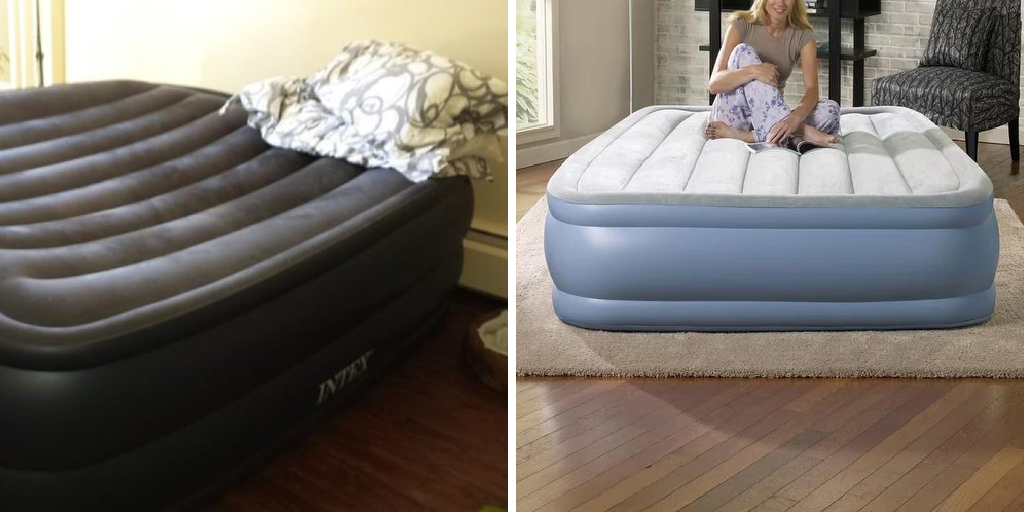
From taking steps to minimize the noise created by motion, adjusting the pressure in your mattress, tackling mold and mildew growth, ensuring proper ventilation for the unit, and utilizing additional noise-reducing materials – we’ll provide tips on how to make air mattress less noisy. Ready to learn more? Read ahead.
Why Does Your Mattress Make Noise When You Move?
Air mattresses are designed to adjust to the contours of your body when you move around, which can sometimes cause a squeaking and popping noise. The best way to avoid this is to purchase an air mattress constructed with motion-reducing technology.
Additionally, if your mattress is made from plastic or vinyl material, it’s more prone to making noise. Instead, look for an air mattress made of thicker and more durable materials such as rubber or PVC.
Overall, it’s important to look for a high-quality mattress made with superior materials if you’re looking to buy an air mattress that will be as quiet as possible.
What Will You Need?
To make your air mattress less noisy, you may need the following items:
- Patch kit
- Seam sealer glue
- Rubber matting
- Foam padding
- Mold and mildew remover or baking soda
Once you have the necessary supplies, you can begin making changes to reduce noise from your air mattress.
10 Easy Steps on How to Make Air Mattress Less Noisy
Step 1. Find & Repair Leaks:
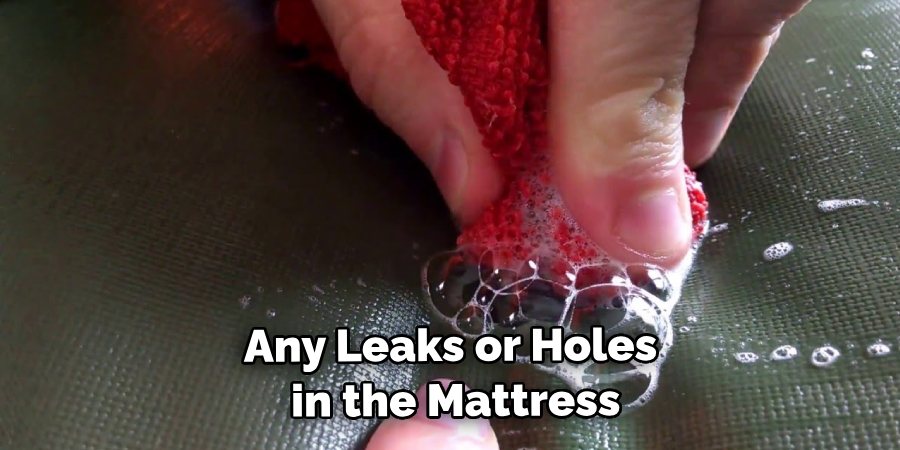
The first step is to identify if there are any leaks or holes in the mattress. The sound of escaping air can often be the cause of the annoying noise.
to seal these up. Ensure the mattress is fully deflated before applying the patch, and let the adhesive dry completely before re-inflating.
Step 2. Adjust the Air Pressure:
An overinflated air mattress can become firm and make more noise with each movement. Try deflating the mattress until you find a comfortable level that reduces the noise. Remember, the goal is to balance comfort and noise reduction. Too little air can lead to an uncomfortable sleep, while too much air might increase the noise. Experiment until you find the perfect balance.
Step 3. Use a Rubber Mat or Foam Padding:
Using a rubber mat or foam padding under your air mattress can absorb the noises caused by friction between the mattress and the floor. Place the mat or padding between the mattress and the floor surface, ensuring that it is evenly distributed and covers the entire area beneath the mattress. This can reduce noise and provide extra insulation, particularly if you’re camping or sleeping on a cold floor.
Step 4. Clean and Dry the Mattress Regularly:
Mold and mildew can cause your air mattress to produce a crackling or popping sound. To mitigate this, cleaning and drying your air mattress regularly is important. If you notice any signs of mold or mildew, use a remover or baking soda to clean it. Make sure you dry the mattress thoroughly before inflating it again. Poorly dried mattresses are prone to mold and mildew, which can inevitably lead to more noise. Regular cleaning and maintenance will make your air mattress less noisy and prolong its life.
Step 5. Maintain Proper Ventilation:
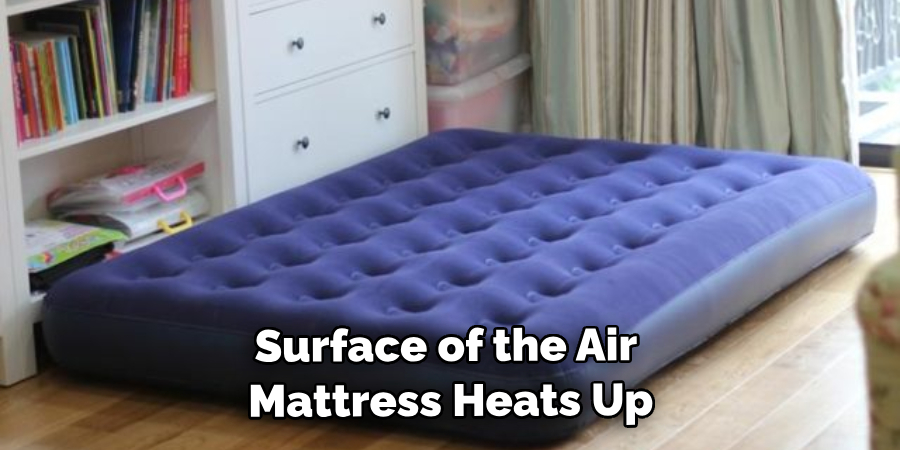
Another cause of noise can be the heating of the mattress due to poor ventilation. When the surface of the air mattress heats up, it can result in increased noise and discomfort. To prevent this, ensure your sleeping area is well-ventilated, particularly in warmer weather. This can help to keep the mattress cool and reduce noise. If you are indoors, consider using an air conditioner or fan to improve air circulation. If you’re camping, try to set up your tent in a shaded area and leave the tent flaps open for better airflow.
Step 6. Use Noise-Reducing Materials:
Materials like foam toppers or mattress pads can be a great addition to your air mattress setup. Not only do they provide an extra layer of comfort, but they can also absorb some of the noise produced by movement on the mattress. Choose a topper or pad that fits your mattress size and lay it over the top before adding your sheets. You’ll be surprised at how much this simple addition can help make your air mattress less noisy.
Step 7. Limit Movement:
Excessive movement on the air mattress can cause squeaking and other noises. Try to limit your movement as much as possible while you’re on the air mattress. If you’re sharing the mattress with someone else, consider using separate blankets to minimize motion transfer. This can reduce the amount of noise produced by tossing and turning. Remember, the more you move, the more noise the mattress will produce.
Step 8. Regularly Deflate and Re-inflate the Mattress:
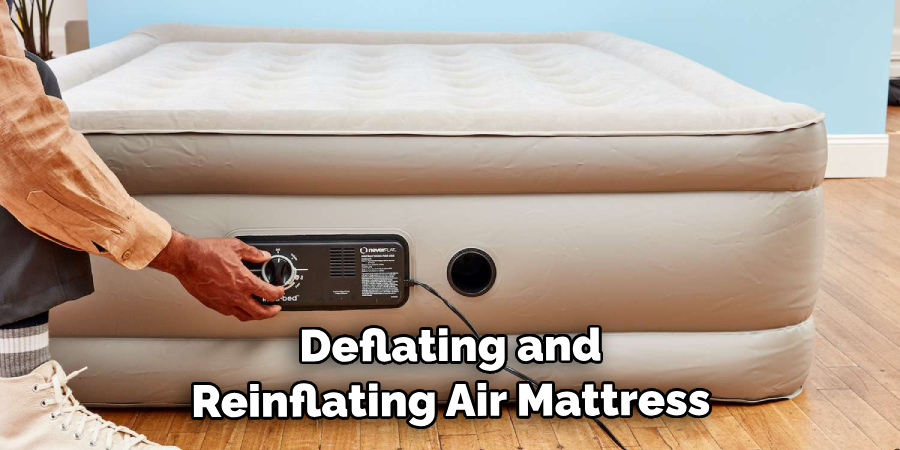
The composition of the air inside your mattress can affect the amount of noise it makes. Regularly deflating and re-inflating your air mattress can help maintain optimal air pressure and reduce noise. This process also allows you to adjust the firmness of the mattress to your preference. However, be careful not to overinflate, as this can lead to unnecessary noise and potential damage to the mattress. Remember that temperature changes can affect air pressure, so you may need to adjust the air in your mattress depending on the weather.
Step 9. Use a Mattress Cover:
A mattress cover can serve dual purposes – it can mute noise and protect your air mattress from potential damage. Choose a thick, quilted cover for maximum noise reduction. These pads are designed to absorb the sounds of movement and add extra comfort to your sleeping surface. Ensure the cover fits your air mattress properly to avoid slippage and bunching, which could lead to additional noise.
Step 10. Check the Pump:
The pump used to inflate your air mattress can also be a significant source of noise. If your pump makes excessive noise, consider replacing it or investing in a quieter model. A manual pump can be a quiet alternative to an electric one. Also, ensure the pump is properly attached and sealed during inflation to prevent unwanted noise.
By following these steps, you should have a quieter and more peaceful sleeping experience on your air mattress. Remember, regular maintenance and care for your air mattress can go a long way in preserving its quality and reducing noise.
5 Additional Tips and Tricks
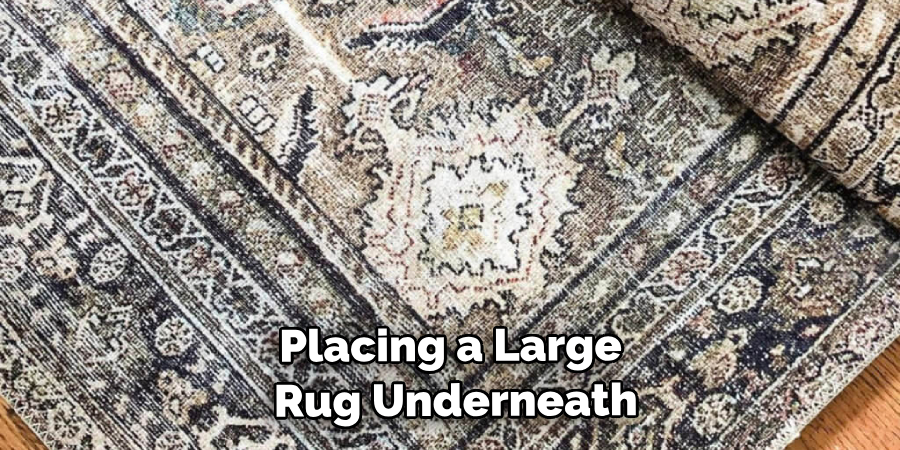
- Use a Mattress Topper: Acquire a thick, quality mattress topper. This improves the comfort level and reduces the squeaky sounds produced when you move on the air mattress. The topper absorbs most of the friction that causes the noise.
- Place a Rug or Carpet Underneath: You can significantly reduce the noise produced by placing a large rug or carpet underneath the air mattress. This is because the rug acts as a sound absorber, reducing the friction between the mattress and the floor, which often causes noise.
- Regularly Check for Air Leaks: Air leaks can also contribute to the noise produced by an air mattress. Keep your mattress well-inflated and regularly check for any possible leaks. If found, patch them up promptly to minimize noise and enhance sleep quality.
- Use Lubricant: If you notice any squeaks coming from your air mattress, applying a small amount of lubricant (such as WD-40) should help reduce the noise. However, be sure to use only a bit and test it on an inconspicuous part of the mattress before using it all over.
- Keep sharp objects or accessories away: If you are using any accessory or sharp object with your air mattress (such as a bed frame, metal railing, or a bedsheet), keep them away from the mattress to reduce noise. Sharp edges can damage and create noisy holes in the material, making it more difficult to sleep. Be sure to use protective layers if needed.
By following these tips and tricks, you can make sure that your air mattress is as quiet as possible so you can get the best sleep possible.
5 Things You Should Avoid
- Avoid sleeping directly on the mattress: Instead, use a thicker sheet or cover that helps reduce friction between you and the mattress. This can help minimize any noise produced while you are asleep.
- Don’t Over-inflate: Over-inflating your air mattress can often lead to an uncomfortable sleep experience and increased noise levels due to the increased tension on the mattress.
- Don’t Underestimate Weight Limits: Most air mattresses come with a specified weight limit in order to ensure their durability and quality. If you exceed this weight limit, it can increase the chances of noise production and wear and tear on your mattress.
- Avoid Plastic Beddings: Plastic sheets or bedding can often increase the noise your air mattress produces. This is because they are more likely to cause friction and squeaks when you move on them.
- Don’t Use Unsupported Frames: It is important to ensure that the frame you use with your air mattress is compatible and well-supported. An unsupported frame can cause instability, which increases the chance of noise production.
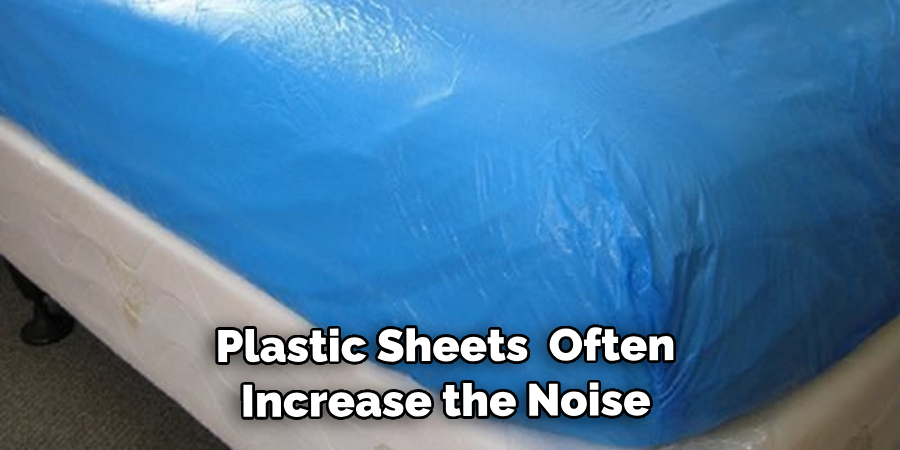
By avoiding these practices, you can help keep your air mattress as silent and comfortable as possible so that you can get a peaceful night’s sleep!
Is It Good to Sleep on Air Mattress?
Yes, air mattresses are generally considered a good option for sleeping as they provide a comfortable and supportive sleep surface.
However, it is important to remember that some models can be quite noisy and may require special care and maintenance to reduce this noise. By following the tips and tricks outlined above, you should be able to minimize any noise produced by your air mattress while still enjoying a comfortable sleep experience!
In addition, you should also ensure that you are using the right kind of bedding and accessories for your air mattress to help reduce noise as well. For example, it is best to use a thicker sheet or blanket and avoid plastic bedding if possible. It is also important to ensure that your mattress is kept well-inflated and you are not exceeding the specified weight limit. All these factors can help reduce the noise your air mattress produces significantly!
Overall, sleeping on an air mattress can be a comfortable and relaxing experience with the right care and maintenance. As long as you are mindful of some key tips, it should be perfectly safe and comfortable to do so.

Conclusion
Some air mattresses are too noisy and can be disruptive, resulting in a lack of sleep. Fortunately, a few simple tricks make an air mattress quieter and more peaceful. Sturdy bed frames can reduce noise from the mattress, as can mattress pads and sleeping surfaces that will absorb shock from movement. Adjust the air in your mattress so that it fits correctly and there is no excess pressure, which can cause punishing creaking noises.
Finally, regular inspection and maintenance services on your mattress might also help improve its durability and performance over time.
Hopefully, the article on how to make air mattress less noisy will help you in your quest to find a quieter air mattress for a good night’s sleep. With careful consideration and maintenance, you should be able to enjoy peaceful nights without disruption from noisy mattresses!
